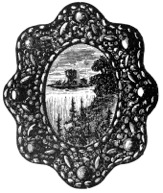By Talia Schaffer
Charles Dickens was born 200 years ago this week, but he is very much alive in our culture, having become associated with two ways of seeing the world: “Dickensian” is now shorthand for filthy urban misery, but it is also linked to domestic bliss, the cozy armchair with the rubicund host, the plump goose and the fragrant, steaming punch. The man whose attack on the workhouses has resonated for two centuries is the same man who popularized the modern Christmas.
Interestingly, these two modes are linked by their obsession with (of all things) garbage. The dirt of Victorian London needs no introduction. In Bleak House, the homeless illiterate Jo is a street sweeper, spending his days trying to push back a tide of pestilent mud, horse droppings, ashes, decayed cats. Our Mutual Friend famously centers on three giant mounds of dust. But how was rubbish enshrined in the domestic home?
The answer is that one of the most important values in Victorian domestic organization was the recycling of detritus, and Dickens recognized that. In Our Mutual Friend, the villains steal waste products — they ransack corpses, they try to take the Mounds — but the good characters turn those products into delightful artifacts. Jenny Wren is a dolls’ dressmaker, buying shreds of waste cloth, ribbon ends, and damaged beads, and snipping them into costumes. Mr. Venus articulates skeletons, wiring dusty bones and stray teeth together to make his art.
 Jenny and Mr. Venus are professionals, but their first readers loved them because they are participating in one of the most popular amateur pursuits in the nineteenth century. Victorian domestic handicrafters were urged to glue plum pits to mirrors, to melt leftover candle ends to cover plaster statuettes, to varnish scraps of leather to resemble wood. They exulted in turning household waste into decorative spectacles to prove their managerial skill. In this way, Victorian women could emulate industrial production, making it very different from modern crafts, which embrace an ethos of handmade uniqueness. Just as factories took in raw materials like dead horses or coal, turning out other products, so too did craftswomen process the debris of the home. They had no interest in learning age-old artisanal traditions; rather, they wanted to prove themselves participants in modernity.
Jenny and Mr. Venus are professionals, but their first readers loved them because they are participating in one of the most popular amateur pursuits in the nineteenth century. Victorian domestic handicrafters were urged to glue plum pits to mirrors, to melt leftover candle ends to cover plaster statuettes, to varnish scraps of leather to resemble wood. They exulted in turning household waste into decorative spectacles to prove their managerial skill. In this way, Victorian women could emulate industrial production, making it very different from modern crafts, which embrace an ethos of handmade uniqueness. Just as factories took in raw materials like dead horses or coal, turning out other products, so too did craftswomen process the debris of the home. They had no interest in learning age-old artisanal traditions; rather, they wanted to prove themselves participants in modernity.
For instance, one popular craft involved turning fish scales into homemade sequins: soaking the scales, snipping them with special tiny shears, and piercing them with a needle, before sewing them onto silk. The pleasure in the fish-scale craft came from the creative recycling of trash, and the sense that one could make something as well as a machine did. To churn out identical, swift copies of objects, using premade kits and instructions from mass-circulation magazines and pamphlets, was to reach this ideal.
Handicraft fulfilled other goals, some of them contradictory. Handicraft, for instance, was usually temporary; made of homemade paste and bits of paper, it was designed to fall apart so the maker would have an excuse to bring in something new. For craft was seen as a fashion, to be updated frequently, not as a timeless piece of art.
0 Comments on Charles Dickens and garbage as of 1/1/1900


